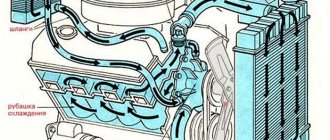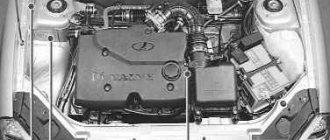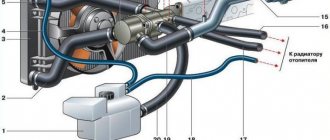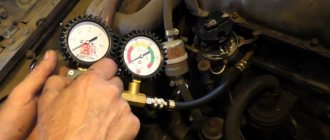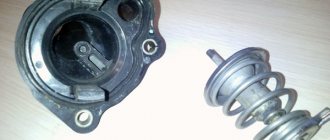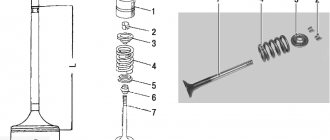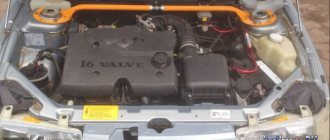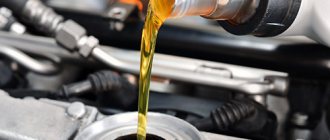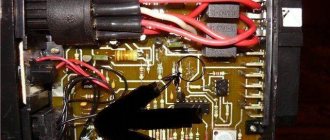Cooling system design
The engine cooling system has many components that are interconnected, and if one fails, the entire system will not be able to function. So, let's look at the location diagram and decoding of the indicators for the cooling system of a 16-valve engine.
Diagram of the cooling system operation
1 – heater radiator; 2 – steam removal hose of the heater radiator; 3 – outlet hose; 4 – supply hose; 5 – coolant temperature sensor (in the block head); 6 – pump supply pipe hose; 7 – thermostat; 8 – filling hose; 9 – expansion tank plug; 10 – coolant level indicator sensor; 11 – expansion tank; 12 – exhaust pipe; 13 – liquid chamber of the carburetor starting device; 14 – radiator outlet hose; 15 – radiator supply hose; 16 – radiator steam outlet hose; 17 – left radiator tank; 18 – sensor for turning on the electric fan; 19 – fan electric motor; 20 – electric fan impeller; 21 – right radiator tank; 22 – drain plug; 23 – electric fan casing; 24 – timing belt; 25 – coolant pump impeller; 26 – supply pipe of the coolant pump; 27 – coolant supply hose to the throttle pipe; 28 – coolant drain hose from the throttle pipe; 29 – coolant temperature sensor in the outlet pipe; 30 – radiator tubes; 31 – radiator core.
Cooling system problems
If you notice that the operating temperature of the VAZ 2114 engine does not correspond to the norm (both up and down), then first of all the reason should be looked for in the cooling system.
Its most important components that directly affect engine temperature are:
- radiator;
- pipes;
- water pump;
- thermostat.
Cooling system VAZ 2114
Thus, the first thing to check when the engine overheats is the radiator.
There are only 3 main reasons why it may not function correctly:
- Lack of coolant in the system.
- Cooling grid clogged.
- Leak.
In the first case, you should check the fluid level and, if necessary, top it up. In the second case, you will have to dismantle the radiator and clean it (both internal and external purging). In the third case (if a leak is detected), you can either use soldering or use a special sealing compound for radiators, and then add coolant to the normal level.
Antifreeze level VAZ 2114
In some, especially advanced, cases, a complete replacement of the radiator may be required. It is not worth saving and trying to restore a “dead” radiator, since its incorrect operation can lead to severe wear and even damage to the engine, as a result of which a major repair will cost a much larger sum.
The next thing you have to check when troubleshooting is the cooling system pipes. With prolonged use, they can become “obsolete” with the further formation of cracks, which may result in a leak of coolant. If it turns out that the pipes have indeed leaked, they should simply be replaced with new ones, and the problem will be solved.
VAZ 2114 pipes
If it turns out that both the radiator and the pipes are working properly, you should check the pump (liquid pump). This can be done by replacing it with a new one of a similar model. If after such a replacement the operating temperature of the VAZ 2114 8-valve engine returns to normal, then this means that this was the reason.
Engine operating temperature on VAZ-2110
Engine operating temperature shown on the instrument panel
If we take the information from the international convention of automobile manufacturers dated December 1, 1992, then the uniform standard for engine operating temperature is considered to be 90 degrees Celsius. With such indicators, the engine operates as efficiently as possible and does not create residual negative effects.
When switching to more advanced engine manufacturing technologies in 2004, it was accepted that a specific indicator of this indicator cannot be held in one position, and therefore they made a gradation of acceptable standards, which amounted to 85-105 degrees Celsius.
According to data from the manufacturer AvtoVAZ, on a 16-valve VAZ-2112 engine, the operating temperature of the engine is considered to be 87-103 degrees Celsius. At this temperature, all systems function normally, and the motor is not subject to negative factors and consequences.
Operating temperature of the VAZ 21124 16 valve engine
bought 21124, 2005. 16kl.1.6. The car keeps 90 degrees in cool weather, well it rises to 105-110 and the Carlson turns on, but now it’s hot and it constantly stays around 100-110, almost all the time the turntable turns on itself, when it’s working it reaches 130 and sometimes It stays and drops to 100 degrees, but what’s amazing is the temperature is in the red zone, and the car doesn’t boil. Tell me what it is and what can be done. thanks in advance.
Di-pal:
, when it works, it reaches 130 and sometimes it stays and drops to 100 degrees #
Temperature measurements must be taken on a computer, since the dial gauge on the panel can lie!
at 130g your liners would melt, let alone the antifreeze boil
to Di-pal:
Check the condition of the pipes. There may be problems in the coolant (air in the system), the radiator is clogged or the system itself. Also the pump.
There was antifreeze in the system, I blew it out and filled it with antifreeze, no difference
to Di-pal:
Is the radiator clean from the outside? Are there any gaps between the lamellas?
to Vladimir Almera N16 2005:
on the highway at a speed of 100-120 in 5th gear the temperature is normal 90 degrees, but in the city with aggressive driving it reaches 130 degrees, can the needle really do that?
to vlad_m:
I washed the radiator from Karcher, so it’s clean.
Check the pump and thermostat.
to Di-pal:
and for air locks.
Di-pal:
when it works, it reaches 130 and sometimes it stays and drops to 100 degrees, but what is surprising is that the temperature is in the red zone, but the machine does not boil. #
Once again, do not trust the arrow readings! If the engine does not boil, then the temperature is normal! If in doubt, check the temperature on a computer at a car service center or with a mercury thermometer yourself, don’t panic, you can go through the whole car and the result will be the same
to mATr1xX:
I changed the thermostat, there is no difference, removing the plug does not help, and if the pump did not work, there would be no circulation.
to Vladimir Almera N16 2005:
checked through the computer it shows everything is correct there 90 and 90 here, 110 there and here 110 but for some reason it did not heat up to 130 during diagnostics.
Maybe just change the temperature sensors. They send a signal to the ECU, and it turns on the carloson.
to Di-pal:
Your reason is very simple! and as a rule it is very difficult to find (little known).
There is no need to change or experiment!
Just take and change the polarity of the wires going to the radiator fan and you will be pleasantly surprised at the correct operation of water cooling. Your fan blows in the opposite direction, that is, it needs to go from the street to the engine compartment, but yours is completely the other way around, from the engine compartment compartment to the street.
Good luck
80-100 km/h. Mine stays at 100C (in the current weather), and if you turn off the stove, it reaches 103C and this confuses me. Maybe it's worth changing the thermostat? I tightened/replaced all the clamps, replaced the expansion tank cap, but this did not give any result. According to my feelings, the part of the thermostat that is responsible for the large circle of the cooling system begins to heat up intensely after a temperature of 92C. The temperature was controlled by BC. The fan is on/off in the range of 105-101 (as provided for this controller), the readings of the BC and the temperature indicator on the dashboard correspond to each other. There seems to be no crime yet, because... the temperature does not exceed a critical value, but is there something wrong here, or am I wrong?
water pump
The water pump is responsible for the complete circulation of coolant through the cooling and heating system. Antifreeze leaking from under the pump.
Maintaining the normal operating temperature of the antifreeze also depends on the efficiency of the pump. The main pump malfunctions include bearing failure, leakage and destruction of the pump impeller. This can occur as a result of both physical damage to the impeller and destruction as a result of cavitation processes. Cavitation is most often caused by the use of low-quality antifreeze or untimely replacement.
Basic cooling system malfunctions
The reason why the operating temperature range on a VAZ-2114 engine with 16 or 8 valves may change is the failure of parts of the cooling system. Almost every component of it is capable of changing the engine temperature in one direction or another.
- If the radiator is faulty, then most often the temperature rises. First of all, this is due to its clogging. It is enough to clean the grille of this part from debris and dust and the temperature indicators return to normal. If the radiator leaks, then more expensive repairs will be required, including soldering it or completely replacing it. Nevertheless, the radiator is one of the most reliable parts of the VAZ-2114.
- The pipes of this car are the weaker components of the cooling system. An increase in temperature in the engine is associated with wear of the pipes, which causes delamination and cracks to appear in them. Through these damages, coolant leaks out, causing the temperature in the power unit to rise.
- If the water pump fails, you will have to replace it. This unit may produce too little pressure or leak altogether, which will practically stop the circulation of fluid in the system.
- Most often, car enthusiasts are faced with a faulty thermostat. This is a rather capricious part that has to be changed from time to time. In winter, jamming of the thermostat is not so bad; it will be stuck in a small circle, this will be enough for the normal functioning of the engine. In the summer, the radiator fan will work continuously, but it will still not be able to cope with the increase in temperature. The thermostat must be replaced as soon as possible after it breaks. Experienced car enthusiasts recommend installing a more advanced model of this element from a Lada Granta car.
- If the fan installed on the radiator malfunctions, the power plant will boil in almost 100% of cases, especially when the thermostat fails at the same time.
Thermostat
Most of the complaints are made specifically to the thermostat, the bypass valve, which directs the coolant in a full or small circle, depending on the degree of heating. Thermostat location under the hood.
For example, the engine may not warm up to the legal 87–90 degrees due to a stuck valve. However, most often thermostat malfunctions occur due to the quality of the thermoelement. Despite the fact that each thermostat is marked on the body, which indicates the valve response temperature, the indicated temperature does not always correspond to reality.
So, at the specified operating temperature of 85 degrees, the thermostat can pass liquid in a large circle already when warming up to 75–80 degrees. As a result, the temperature will not correspond to the norm, the engine will not be able to warm up to the optimal value. The only solution is to test the thermostat before installation. To do this, the thermostat body is placed in a vessel with water and heated to the specified temperature, periodically checking the condition of the valve. A discrepancy between the thermostat response temperature, even by 3–5 degrees, will not allow you to obtain the optimal operating temperature while driving.
Sensors, ECU firmware and fan
The accuracy of the coolant temperature sensor also greatly affects operating temperature. The temperature sensor is located near the thermostat housing.
The sensor sends an electrical impulse to the electronic control unit, which in turn gives a command to start the cooling fan. The normal temperature at which the fan should start is 105 degrees. If the sensor readings are incorrect, the fan will start earlier (in this case, the antifreeze will not warm up to normal) or later. Then the engine may overheat and the antifreeze may boil, especially antifreeze of poor quality.
Why do you need to adjust the fan temperature?
In addition to the not-so-thought-out fan response system to temperature changes, we also get a noisy electric motor that will drown out the music, and in addition the incorrect behavior of the coolant temperature control sensor. We looked into how the temperature sensor works and how it drives the electric fan on 16-valve Priora and VAZ 2110 engines not long ago.
Standard temperature sensor VAZ 2110
Moreover, the firmware of the electronic engine control unit also does not always work correctly, so diagnosticians persistently invite those who are dissatisfied with the operation of the fan to re-flash it. And yet the biggest problem with turning on the fan is that it does not have several operating modes, but throws everything out at once. Naturally, this leads to a sharp drop in voltage in the on-board network, and if it is heavily loaded with additional equipment, then this does not lead to anything good. That is, the fan on VAZ 21126 engines has a number of problems:
Read more: How much does a Dodge Challenger Demon cost?
there are no additional operating modes, the motor always works at full strength;
excessive fan performance is good in traffic jams and in hellish heat, but not in normal engine operating modes;
the electric motor makes a lot of noise and nothing can be done about it;
the on-board network can be heavily overloaded with current at the moment the electric motor starts;
in many cases, the starting temperature of the fan does not correspond to the operating conditions and many would like to shift the lower temperature threshold another 5-7 degrees lower to avoid engine overheating.
Based on this, many people think about how to adjust the temperature at which the fan turns on.
Airlock
In addition, an air lock in the cooling system can greatly interfere with the circulation of coolant.
A plug may occur after the liquid boils, as well as due to improper replacement of antifreeze or depressurization of the system. As a rule, air is removed from the cooling system through the throttle body pipe, as the highest point of the closed cooling system. After removing the plug, the engine will warm up to rated temperature and will not overheat.
Air is removed through the throttle body pipe after the engine has warmed up to operating temperature.
